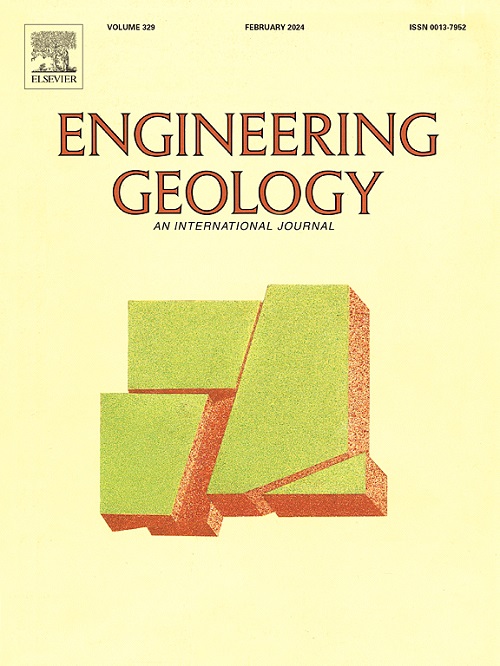反复冲击作用下加筋土路堤响应的数值研究
IF 6.9
1区 工程技术
Q1 ENGINEERING, GEOLOGICAL
引用次数: 0
摘要
地基加筋路堤是一种有效的、环保的岩崩治理技术。这些土结构是用夯实的土壤层、土工织物、土工格栅、金属丝条或网交替建造的。GRE的设计初衷是为了在其使用寿命期间承受岩石的反复冲击,但对这种冲击条件下GRE响应的实验或数值研究很少。对岩石反复冲击作用下的GRE响应进行了全面的数值研究。GRE是由几层由土工合成材料包裹的沙子建造的。采用一种先进的砂土弹塑性本构模型。对于用致密松散砂土建造的减振器,大部分冲击能通过土体的塑性变形来耗散。砂石密度对砂石的变形破坏机制有主导影响。在重复冲击过程中,靠近冲击位置的构件随着平均有效应力和密砂中米塞斯应力的增大而失效。然而,随着平均有效应力的减小和米塞斯应力的增大,土元达到破坏状态。由于土体刚度和抗剪强度较高,孔隙率越低,土体的变形积累越少。松散砂土经过多次冲击后会形成剪切带,而致密砂土主要在冲击点处出现应变局部化。本文章由计算机程序翻译,如有差异,请以英文原文为准。
Numerical investigation on the response of ground-reinforced embankments under repeated impact
Ground-reinforced embankment (GRE) is an effective and environmentally friendly technique of rockfall intervention. These earth structures are built with layers of compacted soil alternated with geotextiles, geogrills, metallic wire stripes or nets. GREs are designed to sustain repeated rock impact during their service life, but there is very little experimental or numerical research on the GRE response under such impact conditions. A comprehensive numerical investigation of GRE response under repeated rock impact is carried out. The GRE is built with several layers of sand wrapped by geosynthetics. An advanced elastoplastic constitutive model for sand is adopted. For the GREs built with dense and loose sand, most of the impact energy is dissipated by plastic deformation in the soil. Sand density has a dominant influence on the deformation and failure mechanism of GREs. During repeated impacts, elements near the impact location fail with increasing mean effective stress and Mises stress in dense sand. However, soil elements reach failure as the mean effective stress decreases and the Mises stress increases. There is much less deformation accumulation in GRE when the void ratio is lower as the soil has higher stiffness and shear strength. After multiple impacts, shear bands form in loose sand but strain localisation mainly occurs at the impact point for dense sand.
求助全文
通过发布文献求助,成功后即可免费获取论文全文。
去求助
来源期刊

Engineering Geology
地学-地球科学综合
CiteScore
13.70
自引率
12.20%
发文量
327
审稿时长
5.6 months
期刊介绍:
Engineering Geology, an international interdisciplinary journal, serves as a bridge between earth sciences and engineering, focusing on geological and geotechnical engineering. It welcomes studies with relevance to engineering, environmental concerns, and safety, catering to engineering geologists with backgrounds in geology or civil/mining engineering. Topics include applied geomorphology, structural geology, geophysics, geochemistry, environmental geology, hydrogeology, land use planning, natural hazards, remote sensing, soil and rock mechanics, and applied geotechnical engineering. The journal provides a platform for research at the intersection of geology and engineering disciplines.
 求助内容:
求助内容: 应助结果提醒方式:
应助结果提醒方式:


